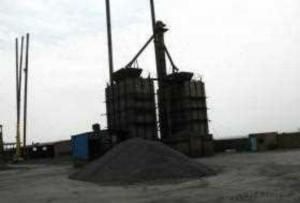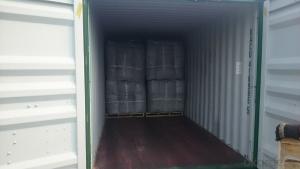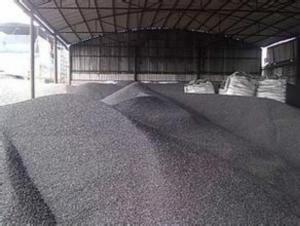GPC with lower Sulphur0.03% max in Low Ash
- Loading Port:
- Qingdao
- Payment Terms:
- TT OR LC
- Min Order Qty:
- 24 m.t.
- Supply Capability:
- 5004 m.t./month
OKorder Service Pledge
OKorder Financial Service
You Might Also Like
Introduction:
it is playing more and more important role in the industryGPC has good characteristics with low ash, low resistivity, low sulphur, high carbon and high density. It is the best material for high quality carbon products. It is used as carbon additive in steel industry or fuel.
Features:
1.Our strong team provide you reliable service that make you feel purchasing is more easier
4. Highest standard of integrity. Guarantee customer's benefit.
5. Supplying Pet Coke, Met coke, Foundry Coke, Carbon Raiser etc.
Specifications:
F.C.% | 95MIN | 94MIN | 93MIN | 92MIN | 90MIN | 85MIN | 84MIN |
ASH % | 4MAX | 5MAX | 6 MAX | 6.5MAX | 8.5MAX | 12MAX | 13MAX |
V.M.% | 1 MAX | 1MAX | 1.0MAX | 1.5MAX | 1.5MAX | 3 MAX | 3 MAX |
SULFUR % | 0.3MAX | 0.3MAX | 0.3MAX | 0.35MAX | 0.35MAX | 0.5MAX | 0.5MAX |
MOISTURE % | 0.5MAX | 0.5MAX | 0.5MAX | 0.5MAX | 0.5MAX | 1MAX | 1MAX |
Pictures



FAQ:
1. Your specification is not very suitable for us.
Please offer us specific indicators by TM or email. We will give you feedback as soon as possible.
3. Do you provide samples?
Yes, samples are available for you to check our quality.
Samples delivery time will be about 3-10 days.
4. What about the lead time for mass product?
The lead time is based on the quantity, about 7-15 days. For graphite product, apply Dual-use items license need about 15-20 working days.
5. What is your terms of delivery?
We accept FOB, CFR, CIF, EXW, etc. You can choose the most convenient way for you. Besides that,
we can also shipping by Air and Express.
6. Product packaging?
We are packed in bulk ship or in ton bag or placing in container or according to your requirements.
7. Notice
please note that the price on Alibaba is a rough price. The actual price will depends on raw materials, exchange rate wage and your order quantity .Hope to cooperation with you, thanks !
- Q: How does carbon affect the taste of food and beverages?
- Carbon can affect the taste of food and beverages by either enhancing or altering their flavor profiles. In the case of carbonated beverages, the added carbon dioxide creates a bubbly sensation, which can give a refreshing and lively mouthfeel. Carbonation also enhances the perception of acidity and can balance the sweetness in some drinks. On the other hand, when carbon-based compounds, such as those found in charred or grilled food, come into contact with heat, they can create smoky or burnt flavors that add depth and complexity to certain dishes. Overall, carbon plays a significant role in influencing the taste and sensory experience of various food and beverage products.
- Q: How does carbon affect the migration patterns of animals?
- The migration patterns of animals are significantly influenced by carbon emissions and the subsequent increase in greenhouse gases. One of the main ways in which carbon affects migration is through climate change. As levels of carbon dioxide rise, the Earth's temperature also increases, leading to changes in weather patterns and the timing of seasons. These alterations can disrupt the natural cues and signals that animals depend on to initiate migration. For certain species, migration is triggered by changes in temperature, daylight hours, or the availability of food sources. However, with climate change, these cues may become inconsistent or modified, resulting in confusion and disruption in migration patterns. Migratory birds, for instance, rely on the presence of insects and other food sources during their journey. Nevertheless, fluctuations in temperatures and shifts in the life cycles of plants and insects can impact the timing and availability of these resources, potentially leading to food shortages and hindering their ability to successfully complete migrations. Furthermore, carbon emissions have caused changes in habitat and ecosystems that further influence migration patterns. Increasing temperatures and alterations in precipitation patterns can change the distribution and abundance of plant species. Consequently, this can affect the availability of food and shelter for migratory animals. Some species may find that their traditional breeding or feeding grounds are no longer suitable due to these changes, compelling them to modify their migration routes or patterns. In addition, carbon emissions also contribute to the melting of polar ice caps and the subsequent rise in sea levels. This directly affects marine species that rely on specific breeding grounds or feeding areas. As their habitats shrink or disappear, these animals may be compelled to migrate to new areas or face extinction. Overall, the rise in carbon emissions and resulting climate change have profound effects on the migration patterns of animals. Disruptions in weather patterns, modified cues for migration, changes in habitat, and shifts in food availability all contribute to the challenges faced by migratory species. Understanding and mitigating the impact of carbon on migration is essential to ensure the survival and well-being of these animals in a rapidly changing world.
- Q: How does carbon contribute to the strength of concrete?
- Carbon can contribute to the strength of concrete in several ways. One of the primary ways is through the use of carbon nanotubes (CNTs) or carbon fibers. These materials are added to the concrete mixture, acting as reinforcement and enhancing its mechanical properties. When CNTs or carbon fibers are incorporated into the concrete, they create a network of small, strong, and lightweight particles. This network helps to improve the overall strength and durability of the concrete, making it more resistant to cracking, flexing, and other forms of structural damage. Additionally, the carbon particles also enhance the bonding between the cement paste and the aggregates in the concrete. This improved bonding increases the interfacial strength, resulting in a stronger and more cohesive concrete matrix. Furthermore, carbon can also contribute to the strength of concrete by acting as a pozzolan. Pozzolans are materials that react chemically with calcium hydroxide, a byproduct of cement hydration, to form additional cementitious compounds. These compounds fill in the gaps between cement particles, resulting in a denser and stronger concrete structure. Carbon black, a type of finely divided carbon, is commonly used as a pozzolan in concrete mixes. Overall, the incorporation of carbon in concrete, whether through carbon nanotubes, carbon fibers, or as a pozzolan, can significantly enhance its strength and performance. By reinforcing the concrete matrix, improving bonding, and filling in gaps, carbon helps to create a more durable and robust material suitable for various construction applications.
- Q: Glucose contains resveratrol (C14H12O3) to determine the mass ratio of resveratrol and carbon dioxide of the same quality as carbon dioxide
- They are x and y, containing carbon equal, according to the mass of an element = the mass of a compound * the elementMass fractionFor C14H12O3, the carbon mass fraction is C%=12*14/ (12*14+12+16*3) *100%=73.68%For CO2, the mass fraction of carbon is 12/ (12+16*2) =27.27%There is x *73.68%=y*27.27%So there's X: y =57:154
- Q: What is the symbol for carbon?
- "C" is the symbol representing carbon.
- Q: What is carbon fiber reinforced polymer?
- Combining carbon fibers with a polymer matrix creates a composite material known as carbon fiber reinforced polymer (CFRP). This material is both strong and lightweight. Carbon fibers are thin and strong, consisting of carbon atoms bonded together in a crystalline structure. These fibers are integrated into a polymer matrix, typically made of epoxy resin, which serves to bind the fibers together and offer support. The resulting combination of carbon fibers and polymer matrix yields a material with a high strength-to-weight ratio, making it suitable for diverse applications. CFRP is recognized for its exceptional stiffness, strength, and resistance to corrosion and fatigue. It finds extensive use in aerospace, automotive, sports equipment, and other industries that require lightweight and high-performance materials. Due to its unique properties, CFRP presents an excellent alternative to conventional materials such as steel, aluminum, and fiberglass. It offers superior strength and durability while significantly reducing weight.
- Q: What are the properties of carbon-based ceramics?
- Carbon-based ceramics have a unique combination of properties that make them highly desirable materials. They exhibit excellent high-temperature stability, exceptional chemical resistance, and high mechanical strength. Additionally, they have low density, low thermal expansion, and good electrical conductivity. These properties make carbon-based ceramics suitable for a wide range of applications, including in aerospace, automotive, and electronics industries.
- Q: What is the carbon footprint of different activities?
- The carbon footprint of different activities refers to the amount of greenhouse gas emissions, particularly carbon dioxide, that are produced as a result of those activities. It varies depending on the type and scale of the activity. Activities such as driving a car, flying, using electricity, and consuming meat and dairy products typically have higher carbon footprints compared to activities such as walking, cycling, using renewable energy, and eating plant-based foods. The carbon footprint of an activity is an important measure to assess its environmental impact and to make informed choices towards reducing our carbon emissions.
- Q: How does carbon dioxide affect the growth of marine organisms?
- Carbon dioxide affects the growth of marine organisms in several ways. Firstly, increased levels of carbon dioxide in the ocean can lower the pH, leading to ocean acidification. This change in acidity can have detrimental effects on the growth and development of marine organisms, especially those with calcium carbonate shells or skeletons, such as corals, mollusks, and some plankton species. High levels of carbon dioxide can hinder the ability of these organisms to build and maintain their structures, making them more vulnerable to predation and impacting their overall growth and survival. Furthermore, increased carbon dioxide levels can also affect the physiology and metabolism of marine organisms. Some studies have shown that high levels of carbon dioxide can disrupt the functioning of enzymes responsible for various biological processes, including growth and reproduction. This can lead to reduced growth rates, impaired reproductive success, and overall decreased fitness of marine organisms. Additionally, elevated carbon dioxide levels can also indirectly affect marine organisms by altering the availability and distribution of other important nutrients and resources. For example, increased carbon dioxide can influence the solubility of minerals and trace elements, affecting their bioavailability to marine organisms. This can disrupt nutrient cycling and limit the availability of essential nutrients necessary for growth and development. Overall, the increase in carbon dioxide levels due to human activities can have significant negative impacts on the growth and development of marine organisms. These impacts can disrupt entire marine ecosystems, with potentially serious consequences for biodiversity and the functioning of these ecosystems.
- Q: What are the different types of carbon-based alloys?
- There are several different types of carbon-based alloys, each with unique properties and applications. Some of the most common types include: 1. High carbon steel: This type of alloy contains a high percentage of carbon, typically between 0.6% and 1.5%. It is known for its strength and hardness, making it suitable for applications such as tools, knives, and automotive parts. 2. Low carbon steel: Also known as mild steel, this alloy has a lower carbon content, usually below 0.3%. It is more malleable and ductile than high carbon steel, making it suitable for applications that require forming and welding, such as construction and automotive components. 3. Stainless steel: A popular alloy that contains chromium, nickel, and other elements, stainless steel is highly resistant to corrosion and staining. It is commonly used in kitchen utensils, medical equipment, and construction. 4. Cast iron: This alloy contains a higher carbon content, typically between 2% and 4%. It is known for its excellent heat retention and is commonly used in cookware, pipes, and engine blocks. 5. Tool steel: Designed for making cutting tools, this alloy has a high carbon content, typically between 0.7% and 1.4%. It offers excellent hardness, wear resistance, and heat resistance. 6. Carbon fiber reinforced polymers (CFRP): These alloys consist of carbon fibers embedded in a polymer matrix. They are lightweight, strong, and have high stiffness, making them ideal for applications such as aerospace, sports equipment, and automotive parts. Overall, carbon-based alloys offer a wide range of properties and applications, making them versatile materials in various industries.
Send your message to us
GPC with lower Sulphur0.03% max in Low Ash
- Loading Port:
- Qingdao
- Payment Terms:
- TT OR LC
- Min Order Qty:
- 24 m.t.
- Supply Capability:
- 5004 m.t./month
OKorder Service Pledge
OKorder Financial Service
Similar products
Hot products
Hot Searches


























